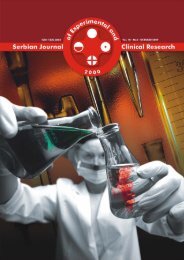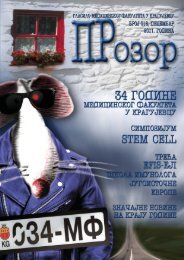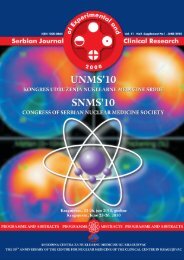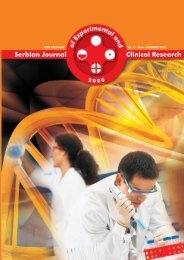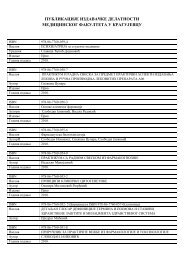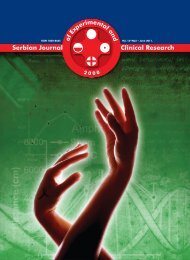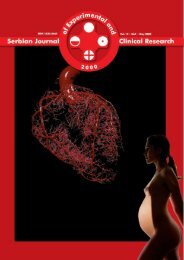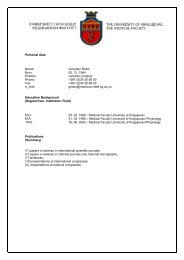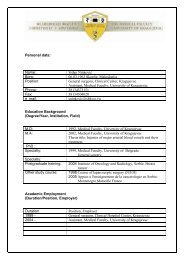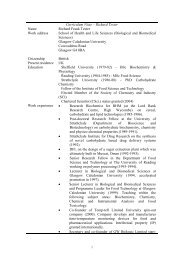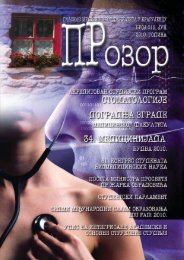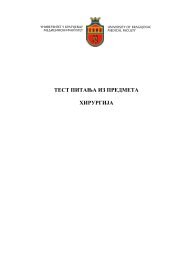neurotoxicity and mechanisms of induced hyperexcitability
neurotoxicity and mechanisms of induced hyperexcitability
neurotoxicity and mechanisms of induced hyperexcitability
You also want an ePaper? Increase the reach of your titles
YUMPU automatically turns print PDFs into web optimized ePapers that Google loves.
in Table 2. The mass spectrum <strong>of</strong> DMP showed that themolecular ion (C 18H 25NO+, m/z = 271) signal representedapproximately 30% <strong>of</strong> the base peak (= 100%) at m/z = 59[C3H9N + ], indicating a moderate stability <strong>of</strong> the molecularion in gas phase compared with codeine [26].The main fragmentation pathway for DMP after ionisationat 8.83 eV consists <strong>of</strong> three principal pathways (paths1-3) as rationalised in scheme 1. The formation <strong>of</strong> the fragmention at signal m/z = 214 (path 1, scheme 1) with R.I.= 26.6% is mainly due to the formation <strong>of</strong> [M-C 3H 7N] + asa loss <strong>of</strong> the C 3H 7N bridge by disruption <strong>of</strong> the C 2–C 18<strong>and</strong>C 10–C 17bonds. It is worth mentioning that this fragmention, C 15H 18O+ (M-C 3H 7), was formed directly from themolecular ion. This formation was confirmed by the fullscan positive ion mass spectrum using t<strong>and</strong>em mass spectrometry(MS/MS) [6] as a prominent peak. Subsequentcleavage <strong>of</strong> the C 7–C 2<strong>and</strong> C 1–C 10bonds (ring B) occurredforming the C 6H 10+fragment ion (m/z = 82, R.I. = 12.5%)(path 1 scheme 1).Two important possible modes <strong>of</strong> fragmentation (paths2 <strong>and</strong> 3 scheme 1) are due to the cleavage <strong>of</strong> the two bondsß to the nitrogen atom (i.e., cleavage <strong>of</strong> C 1–C 10<strong>and</strong> C 9–C 10competitively forming two important fragment ions in themass spectrum.) First, cleavage <strong>of</strong> the C 1–C 10bond <strong>and</strong> formation<strong>of</strong> the most prominent fragment (the base peak) atm/z = 59 (path 2) <strong>of</strong> formula C 3H 9N. Also, cleavage <strong>of</strong> theC 9–C 10bond formed the second prominent peak at m/z =150 (R.I. = 83.0%) with the structure C 9H 12NO (path 3).Structural determinations for the compounds <strong>of</strong> unknownstructure are generally based upon informationobtained through the use <strong>of</strong> a variety <strong>of</strong> modern instruments.The instrumental methods usually include massspectrometric studies, <strong>and</strong> the techniques are well knownto organic chemists <strong>and</strong> scientists [32].It is known that DMP is chemically related to codeine[2] but that it differs in biological effect. DMP is an antitussiveagent used in many nonprescription cough <strong>and</strong>cold medications [1]. Codeine has an analgesic effect [26].Biotransformation (metabolites) in vivo <strong>and</strong> in vitro <strong>of</strong> thetwo drugs has been investigated by many investigators[3–6]. Metabolism studies <strong>of</strong>ten lead to compounds withunknown structures that are related to the material understudy. The chemical structure <strong>and</strong> metabolic pathway <strong>of</strong>DMP were rationalised [5] in Fig. 3.The metabolism <strong>of</strong> DMP is primarily by o-demethylationto dextrophan. DMP is also metabolised to 3-methoxymorphinan<strong>and</strong> 3-hydroxymorphinan.It was noted that from mass spectrum <strong>of</strong> DMP, the signaldue to C 2H 4loss was observed with minor abundancem/z = 243, R.I. = 1.21, which may be due to the formation<strong>of</strong> hydroxymorphinan.Comparing the fragmentation pathway <strong>of</strong> DMP to codeine[26], one can notice that the two drugs are similar inthe initial processes (i.e., loss <strong>of</strong> the bridge C 3H 7N <strong>and</strong> thering opening <strong>of</strong> the two bonds ßto the nitrogen atom). Thesubsequent fragmentation differed because <strong>of</strong> the presence<strong>of</strong> different substituent groups (O <strong>and</strong> OH).ComputationMolecular orbital calculations gave valuable informationregarding the structure <strong>and</strong> reactivity <strong>of</strong> the molecules<strong>and</strong> molecular ions. The computational data supportsthe experimental data. The parameters calculatedusing the MO calculation include geometry, bond order,bond strain, charge distribution, heat <strong>of</strong> formation <strong>and</strong>ionisation energy.The investigation <strong>of</strong> the molecular structure <strong>of</strong> DMPwith the common formula C 18H 25NO was <strong>of</strong> interest in thiswork, <strong>and</strong> this investigation aimed to predict the weakestbond cleavage <strong>and</strong> the stability <strong>of</strong> the neutral molecule byTA <strong>and</strong> the charged molecular by MS.Table 3 shows the comparison <strong>of</strong> computed bondlength, bond order <strong>and</strong> bond strain using the PM3 methodfor neutral <strong>and</strong> molecular cationic forms. Table 4 shows acomparison <strong>of</strong> computed partial charges <strong>of</strong> neutral <strong>and</strong>charged species. The computations reveal some importantresults.1 The charge density localised on the nitrogen atom increasedfrom -0.076 to 0.489 from a neutral to chargedatom, which reveals that the electron disruption uponionisation at 8.83 eV occurs in the nitrogen atom. Noappreciable change in the charge on the other atom wasdue to ionisation <strong>of</strong> the molecule.2 C 2–C 18is the lowest bond order for neutral molecule(0.964) <strong>and</strong> charged cationic form (0.967).Correlation <strong>of</strong> TA, MS <strong>and</strong> MO-calculations.DMP is an essential cough <strong>and</strong> cold medication [1].The drug is chemically related to codeine [2]. As indicatedpreviously [32], a determination <strong>of</strong> initial bond cleavage isan important first step.The scope <strong>of</strong> this investigation was restricted to asearch or prediction <strong>and</strong> discerned the features <strong>of</strong> initialbond disruption during the course <strong>of</strong> fragmentation <strong>of</strong>DMP. Empirical observations indicate that the course <strong>of</strong>subsequent fragmentation is determined to a large extentby the initial bond disruption <strong>of</strong> the molecular ion in MS[34]. It is quite acceptable to say that the computationalquantum chemistry can provide additional data, whichcan be used successfully to interpret both TA <strong>and</strong> MSexperimental results. These theoretical data are particularlyvaluable for mass spectral scientists. These scientistsstudy gas-phase species, which can be h<strong>and</strong>led muchmore easily by quantum chemistry [33].The mass spectrum <strong>of</strong> DMP in gas-phase ion revealedthree competitive processes (1 – 3, scheme 1).PM3 calculation (Table 3) revealed that C 10–N 17wasthe weakest bond in the charged system (weakest bondorder at 0.961, large bond length = 1.484 Aº <strong>and</strong> bondstrain). Moreover, the weakness <strong>of</strong> this bond (C 10–N 17)was due to the presence <strong>of</strong> a lone pair on the nitrogen. Table3 shows that the electron disruption upon ionisationoccurred from the nitrogen, which increased the weak-25



